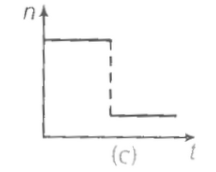Sound waves of wavelength travelling in a medium with a speed of v m/s enter into another medium where its speed is 2v m/s. The wavelength of sound waves in the second medium is:
1.
2.
3.
4.
Speed of sound wave in the air
1. is independent of temperature
2. increases with the pressure
3. increases with increase in humidity
4. decreases with increase in humidity
Change in temperature of the medium changes
1. frequency of sound waves
2. amplitude of sound waves
3. wavelength of sound waves
4. loudness of sound waves
With the propagation of longitudinal waves through a medium, the quantity transmitted is:
1. matter
2. energy
3. energy and matter
4. energy, matter and momentum
Which of the following statements are true for wave motion?
1. Mechanical transverse waves can propagate through all mediums
2. Longitudinal waves can propagate through solids only
3. Mechanical transverse waves can propagate through solids only
4. Longitudinal waves can propagate through a vacuum
A sound wave is passing through the air column in the form of compression and rarefaction. In consecutive compressions and rarefactions,
1. density remains constant
2. Boyle's law is obeyed
3. bulk modulus of air oscillates
4. there is no transfer of heat
Equation of a plane progressive wave is given by . On reflection from a denser medium, its amplitude becomes rd of the amplitude of the incident wave. The equation of the reflected wave is:
1.
2.
3.
4.
A string of mass 2.5 kg is under the tension of 200 N. The length of the stretched string is 20.0 m. If the transverse jerk is struck at one end of the string, the disturbance will reach the other end in:
1. 1 s
2. 0.5 s
3. 2 s
4. data given is insufficient
A train whistling at constant frequency is moving towards a station at a constant speed v. The train goes past a stationary observer on the station. The frequency n' of the sound as heard by the observer is plotted as a function of time t (figure). Identify the expected curve.
1. 2.
2. 
3.
 4.
4. 
A transverse harmonic wave on a string is described by
where x and y are in cm and t is in sec. The positive direction of x is from left to right.
(a) The wave is travelling from right to left.
(b) The speed of the wave is 20 m/s.
(c) The frequency of the wave is 5.7 Hz.
(d) The least distance between two successive crests in the wave is 2.5 cm.
Choose the correct alternatives:
1. (a, b, d)
2. (a, b, c)
3. (b, c, d)
4. (a, c, d)







